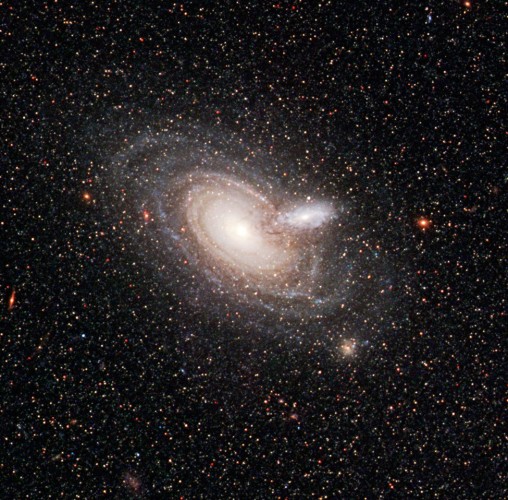
Hubble catches a large and small spiral galaxy similar to the respective dimensions of NGC 1277 and our Milky Way.
Sometimes I dream that, one day, we’ll be studying what we think is a natural object or event in the universe of incomprehensible scope, only to eventually learn it’s a manufactured item. That didn’t happen today! But it is a nice segue to this interesting cosmic tidbit: astronomers have clocked stars in the nucleus of a small, relatively nearby galaxy and come up with an astonishing discovery: it harbors the largest black-hole in the known universe. And I mean freakishly large!
LA Times — The team measured the speed of the stars close to the galactic heart as they orbited around the black hole — the faster they traveled, the more massive the black hole. Their calculations revealed that the black hole at the center of NGC 1277 held the mass of 17 billion suns. (The Milky Way’s black hole, by comparison, is a mere 4 million solar masses.) And yet this black hole, one of the largest known, dominates a galaxy that is only one-tenth the size and mass of the Milky Way.
Assuming it’s confirmed, how would such a massive black-hole end up at the heart of an itty-bitty galaxy? This one object, which could fit inside our solar system, is as massive as all the stars in an entire medium-sized galaxy. It’s big enough to create a Norma Cluster made up of hundreds or thousands of galaxies. And yet its in a dinky spiral galaxy a few thousand light-years wide. Answer, hard to say since we don’t know a great deal about how the garden-variety super massive black-hole in most galaxies came to be. It’s a mystery, for now.

“how would such a massive black-hole end up at the heart of an itty-bitty galaxy?”
Why would a cat with such a fat belly be surrounded by so few mice?
(Burp)
So, uh, do we need to revise our estimation of which galaxy is eating which now?
Yeah, is there a reason ‘it ate most of the galaxy’ isn’t the logical conclusion?
“how would such a massive black-hole end up at the heart of an itty-bitty galaxy” – well, it’s itty-bitty now…
Physicalist
Fat ol’ kitty.
Cat herd.
Love that response. Sort of what I was thinking but much funnier.
We don’t know if it ate the galaxy to get that big or if two galaxies were involved in the deep past or what happened. The two methods we think know of for super massive black hole formation are infalling dust and gas somewhat early on — forming an active galaxy or a quasar — and stellar cannibalism later on where double stars get too close, one streaks off and one gets consumed. At this hazy juncture we don’t know a lot about either one, but what we do know suggest they’d have a hard time accouning for it.
I don’t think we even know how supermassive black holes form at all, although it is bound to be some mechanism independent of the usual one (collaspe of large stars). This one is just surprisingly huge.